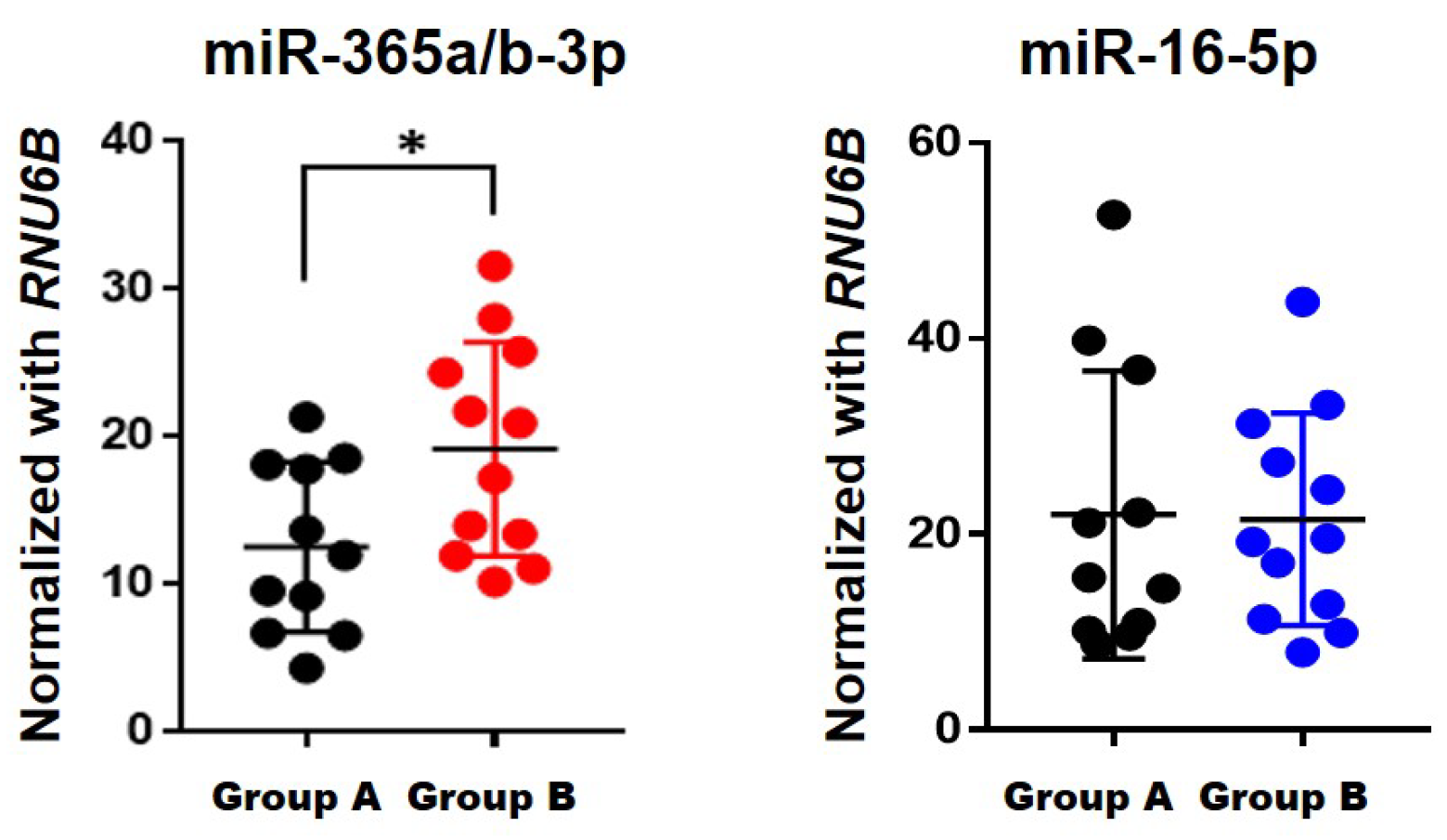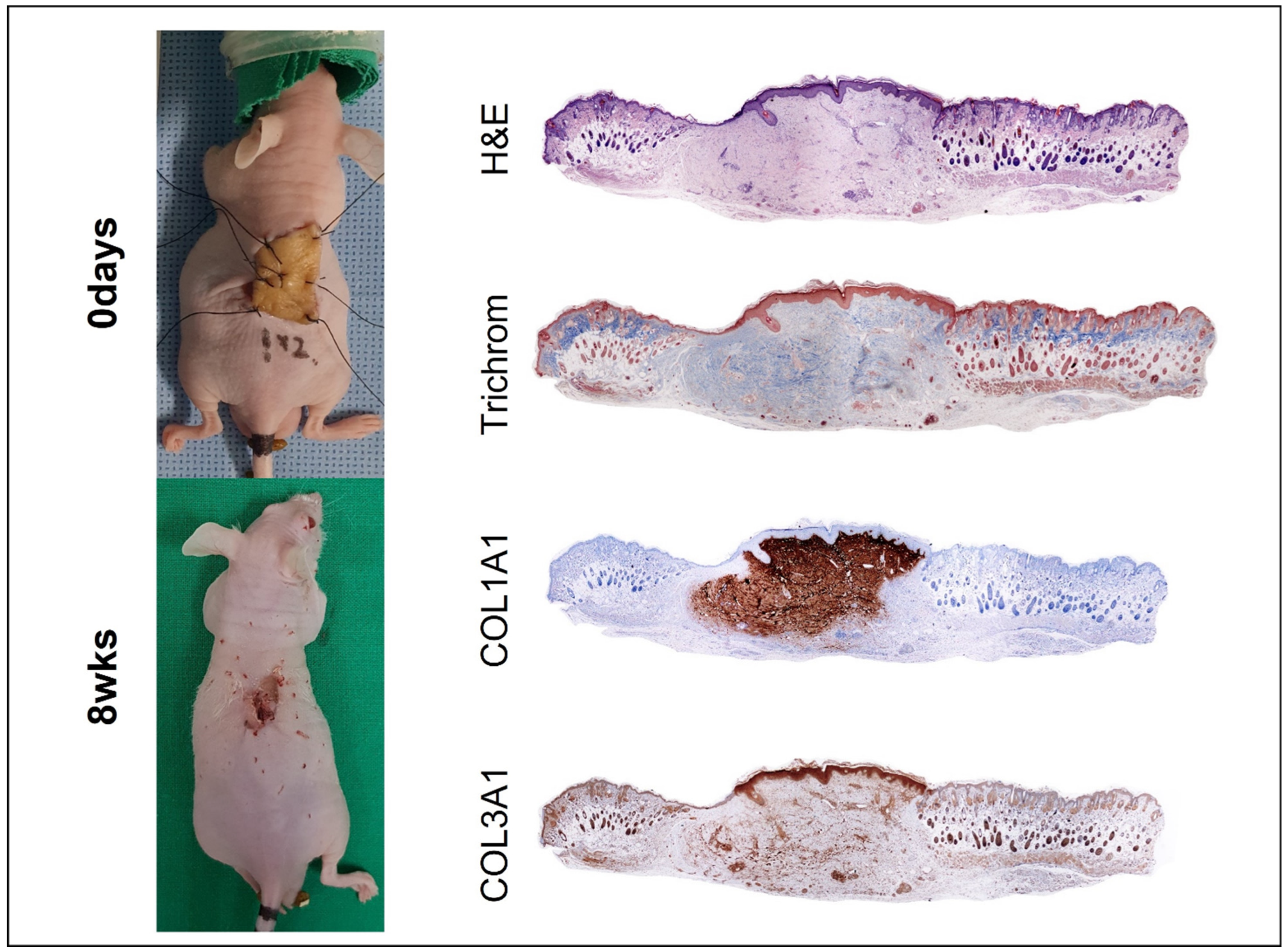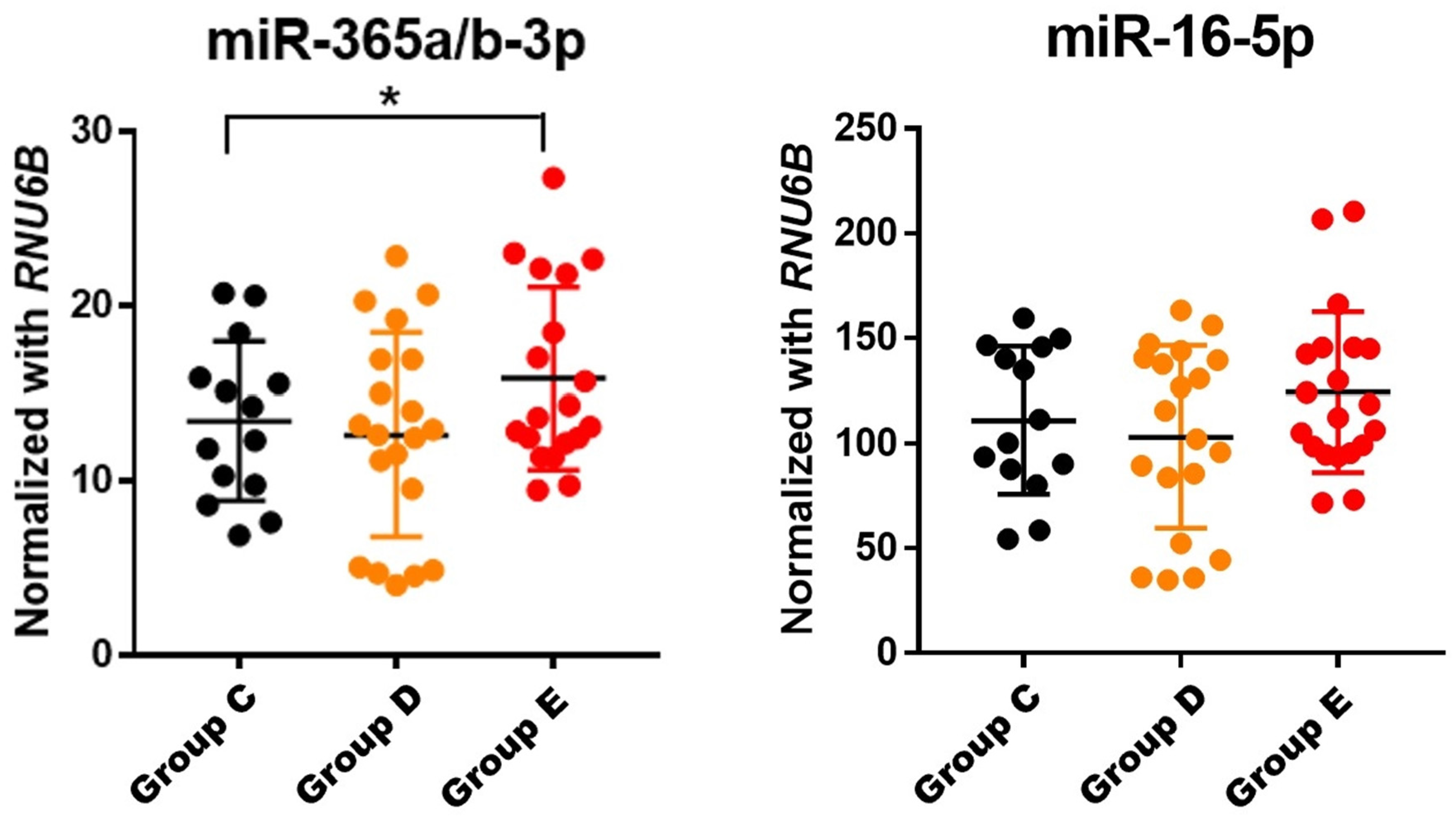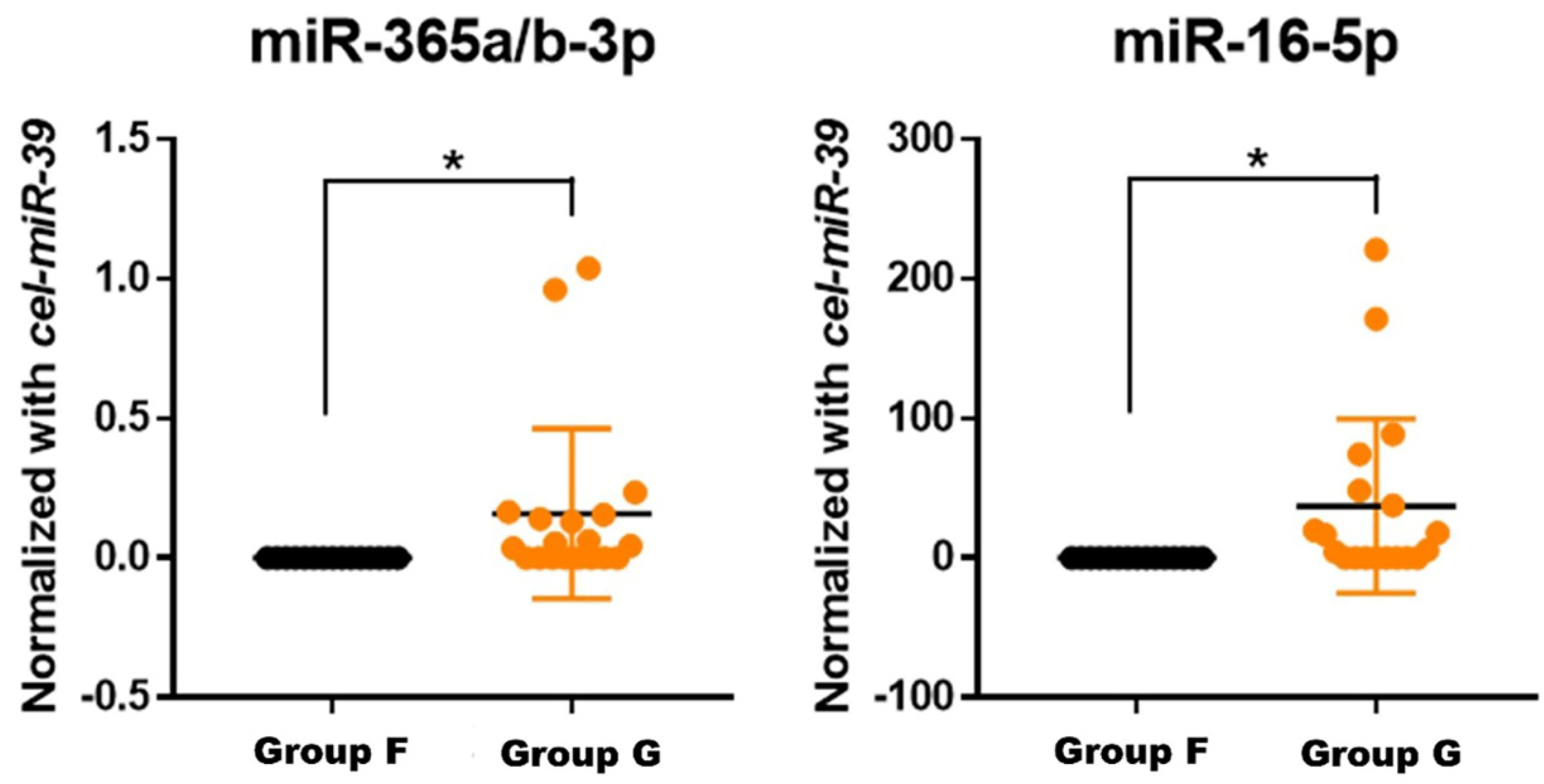MicroRNA-365a/b-3p as a Potential Biomarker for Hypertrophic Scars
Abstract
1. Introduction
2. Results
2.1. MicroRNA Profiling and Validation in Groups A and B
2.1.1. Comparative Analyses of microRNAs in HSs
2.1.2. MicroRNA-365a/b-3p Is Highly Expressed in HSs
2.2. Hypertrophic Scar Mouse Model
2.2.1. Morphologic Observations
2.2.2. Histological Analysis
2.3. Comparison of Tissue miRNA Expression in Groups C, D, and E
2.4. Comparison of Serum Circulating miRNA Expression between Groups F and G
3. Discussion
4. Materials and Methods
4.1. Human Fibroblasts and Myofibroblasts Culture
4.2. MicroRNA Profiling and Validation
4.3. Hypertrophic Scar Mouse Model
4.3.1. Transplantation of Skin Xenografts
4.3.2. Histological Analysis
4.4. Comparison of microRNA Expression
4.4.1. Tissue miRNAs
4.4.2. Serum Circulating miRNAs
4.4.3. miRNA Expression Analysis
4.4.4. Statistical Analysis
Author Contributions
Funding
Institutional Review Board Statement
Informed Consent Statement
Data Availability Statement
Acknowledgments
Conflicts of Interest
References
- Lee, H.J.; Jang, Y.J. Recent Understandings of biology, prophylaxis and treatment strategies for hypertrophic scars and keloids. Int. J. Mol. Sci. 2018, 19, 711. [Google Scholar] [CrossRef] [PubMed]
- Zhu, Z.; Ding, J.; Shankowsky, H.A.; Tredget, E.E. The molecular mechanism of hypertrophic scar. J. Cell Commun. Signal. 2013, 7, 239–252. [Google Scholar] [CrossRef] [PubMed]
- Wang, X.; Zhang, Y.; Jiang, B.H.; Zhang, Q.; Zhou, R.P.; Zhang, L.; Wang, C. Study on the role of Hsa-miR-31-5p in hypertrophic scar formation and the mechanism. Exp. Cell Res. 2017, 361, 201–209. [Google Scholar] [CrossRef] [PubMed]
- Tomasek, J.J.; Gabbiani, G.; Hinz, B.; Chaponnier, C.; Brown, R.A. Myofibroblasts and mechano-regulation of connective tissue remodelling. Nat. Rev. Mol. Cell Biol. 2002, 3, 349–363. [Google Scholar] [CrossRef]
- Aarabi, S.; Longaker, M.T.; Gurtner, G.C. Hypertrophic scar formation following burns and trauma: New approaches to treatment. PLoS Med. 2007, 4, e234. [Google Scholar] [CrossRef]
- Zhang, Q.; Guo, B.; Hui, Q.; Chang, P.; Tao, K. miR-137 inhibits proliferation and metastasis of hypertrophic scar fibroblasts via targeting pleiotrophin. Cell Physiol. Biochem. 2018, 49, 985–995. [Google Scholar] [CrossRef]
- Armour, A.; Scott, P.G.; Tredget, E.E. Cellular and molecular pathology of HTS: Basis for treatment. Wound Repair Regen. 2007, 15 (Suppl. S1), S6–S17. [Google Scholar] [CrossRef]
- Schäfer, M.; Werner, S. Transcriptional control of wound repair. Annu. Rev. Cell Dev. Biol. 2007, 23, 69–92. [Google Scholar] [CrossRef]
- Xian, C.; Gu, Z.; Liu, G.; Wu, J. Whole wheat flour coating with antioxidant property accelerates tissue remodeling for enhanced wound healing. Chin. Chem. Lett. 2020, 31, 1612–1615. [Google Scholar] [CrossRef]
- Guo, Y.; Huang, J.; Fang, Y.; Huang, H.; Wu, J. 1D, 2D, and 3D scaffolds promoting angiogenesis for enhanced wound healing. Chem. Eng. J. 2022, 437, 134690. [Google Scholar] [CrossRef]
- Tredget, E.E.; Nedelec, B.; Scott, P.G.; Ghahary, A. Hypertrophic scars, keloids, and contractures. The cellular and molecular basis for therapy. Surg. Clin. North. Am. 1997, 77, 701–730. [Google Scholar] [CrossRef]
- Zhou, L.; Wang, Y.; Ou, C.; Lin, Z.; Wang, J.; Liu, H.; Zhou, M.; Ding, Z. microRNA-365-targeted nuclear factor I/B transcriptionally represses cyclin-dependent kinase 6 and 4 to inhibit the progression of cutaneous squamous cell carcinoma. Int. J. Biochem. Cell Biol. 2015, 65, 182–191. [Google Scholar] [CrossRef] [PubMed]
- Zhou, M.; Zhou, L.; Zheng, L. miR-365 promotes cutaneous squamous cell carcinoma (CSCC) through targeting nuclear factor I/B (NFIB). PLoS ONE. 2014, 9, e100620. [Google Scholar] [CrossRef] [PubMed]
- Babalola, O.; Mamalis, A.; Lev-Tov, H.; Jagdeo, J. The role of microRNAs in skin fibrosis. Arch. Dermatol. Res. 2013, 305, 763–776. [Google Scholar] [CrossRef]
- Zhou, R.; Zhang, Q.; Zhang, Y.; Fu, S.; Wang, C. Aberrant miR-21 and miR-200b expression and its pro-fibrotic potential in hypertrophic scars. Exp. Cell Res. 2015, 339, 360–366. [Google Scholar] [CrossRef]
- Li, G.; Zhou, R.; Zhang, Q.; Jiang, B.; Wu, Q.; Wang, C. Fibroproliferative effect of microRNA-21 in hypertrophic scar derived fibroblasts. Exp. Cell Res. 2016, 345, 93–99. [Google Scholar] [CrossRef]
- Nie, J.; Liu, L.; Zheng, W.; Chen, L.; Wu, X.; Xu, Y.; Du, X.; Han, W. microRNA-365, down-regulated in colon cancer, inhibits cell cycle progression and promotes apoptosis of colon cancer cells by probably targeting Cyclin D1 and Bcl-2. Carcinogenesis 2012, 33, 220–225. [Google Scholar] [CrossRef]
- Zhou, M.; Liu, W.; Ma, S.; Cao, H.; Peng, X.; Guo, L.; Zhou, X.; Zheng, L.; Guo, L.; Wan, M.; et al. A novel onco-miR-365 induces cutaneous squamous cell carcinoma. Carcinogenesis 2013, 34, 1653–1659. [Google Scholar] [CrossRef]
- Guo, S.L.; Ye, H.; Teng, Y.; Wang, Y.L.; Yang, G.; Li, X.B.; Zhang, C.; Yang, X.; Yang, Z.-Z.; Yang, X. Akt-p53-miR-365-cyclin D1/cdc25A axis contributes to gastric tumorigenesis induced by PTEN deficiency. Nat. Commun. 2013, 4, 2544. [Google Scholar] [CrossRef]
- Singh, R.; Saini, N. Downregulation of BCL2 by miRNAs augments drug-induced apoptosis—A combined computational and experimental approach. J. Cell Sci. 2012, 125, 1568–1578. [Google Scholar] [CrossRef]
- Hamada, S.; Masamune, A.; Miura, S.; Satoh, K.; Shimosegawa, T. MiR-365 induces gemcitabine resistance in pancreatic cancer cells by targeting the adaptor protein SHC1 and pro-apoptotic regulator BAX. Cell Signal. 2014, 26, 179–185. [Google Scholar] [CrossRef] [PubMed]
- Geng, J.; Liu, Y.; Jin, Y.; Tai, J.; Zhang, J.; Xiao, X.; Chu, P.; Yu, Y.; Wang, S.C.; Lu, J.; et al. MicroRNA-365a-3p promotes tumor growth and metastasis in laryngeal squamous cell carcinoma. Oncol. Rep. 2016, 35, 2017–2026. [Google Scholar] [CrossRef] [PubMed]
- Cheng, J.; Wang, Y.; Wang, D.; Wu, Y. Identification of collagen 1 as a posttranscriptional target of miR-29b in skin fibroblasts: Therapeutic implication for scar reduction. Am. J. Med. Sci. 2013, 346, 98–103. [Google Scholar] [CrossRef] [PubMed]
- Syed, F.; Ahmadi, E.; Iqbal, S.; Singh, S.; McGrouther, D.; Bayat, A. Fibroblasts from the growing margin of keloid scars produce higher levels of collagen I and III compared with intralesional and extralesional sites: Clinical implications for lesional site-directed therapy. Br. J. Dermatol. 2011, 164, 83–96. [Google Scholar] [CrossRef] [PubMed]
- Deng, C.; Zheng, J.; Wan, W.; Zhang, S.; Ding, Z.; Mao, G.; Yang, S. Suppression of cell proliferation and collagen production in cultured human hypertrophic scar fibroblasts by Sp1 decoy oligodeoxynucleotide. Mol. Med. Rep. 2013, 7, 785–790. [Google Scholar] [CrossRef] [PubMed][Green Version]
- Momtazi, M.; Kwan, P.; Ding, J.; Anderson, C.C.; Honardoust, D.; Goekjian, S.; Tredget, E.E. A nude mouse model of hypertrophic scar shows morphologic and histologic characteristics of human hypertrophic scar. Wound Repair Regen. 2013, 21, 77–87. [Google Scholar] [CrossRef] [PubMed]
- Wang, J.; Ding, J.; Jiao, H.; Honardoust, D.; Momtazi, M.; Shankowsky, H.A.; Tredget, E.E. Human hypertrophic scar-like nude mouse model: Characterization of the molecular and cellular biology of the scar process. Wound Repair Regen. 2011, 19, 274–285. [Google Scholar] [CrossRef]
- Huang, D.; Shen, K.H.; Wang, H.G. Pressure therapy upregulates matrix metalloproteinase expression and downregulates collagen expression in hypertrophic scar tissue. Chin. Med. J. 2013, 126, 3321–3324. [Google Scholar]
- Guan, Y.J.; Yang, X.; Wei, L.; Chen, Q. MiR-365: A mechanosensitive microRNA stimulates chondrocyte differentiation through targeting histone deacetylase 4. FASEB J. 2011, 25, 4457–4466. [Google Scholar] [CrossRef]
- Chen, Z.; Zhang, Y.; Liang, C.; Chen, L.; Zhang, G.; Qian, A. Mechanosensitive miRNAs and bone formation. Int. J. Mol. Sci. 2017, 18, 1684. [Google Scholar] [CrossRef]
- Wu, H.; Wang, Y.; Wang, X.; Li, R.; Yin, D. MicroRNA-365 accelerates cardiac hypertrophy by inhibiting autophagy via the modulation of Skp2 expression. Biochem. Biophys. Res. Commun. 2017, 484, 304–310. [Google Scholar] [CrossRef] [PubMed]
- Wehbe, N.; Nasser, S.A.; Pintus, G.; Badran, A.; Eid, A.H.; Baydoun, E. MicroRNAs in Cardiac Hypertrophy. Int. J. Mol. Sci. 2019, 20, 4714. [Google Scholar] [CrossRef]
- Brown, B.D.; Naldini, L. Exploiting and antagonizing microRNA regulation for therapeutic and experimental applications. Nat. Rev. Genet. 2009, 10, 578–585. [Google Scholar] [CrossRef] [PubMed]
- Xu, X.H.; Ding, D.F.; Yong, H.J.; Dong, C.L.; You, N.; Ye, X.L. Resveratrol transcriptionally regulates miRNA-18a-5p expression ameliorating diabetic nephropathy via increasing autophagy. Eur. Rev. Med. Pharmacol. Sci. 2017, 21, 4952–4965. [Google Scholar] [PubMed]
- Gras, C.; Ratuszny, D.; Hadamitzky, C.; Zhang, H.; Blasczyk, R.; Figueiredo, C. miR-145 contributes to hypertrophic scarring of the skin by inducing myofibroblast activity. Mol. Med. 2015, 21, 296. [Google Scholar] [CrossRef] [PubMed]
- Hur, K.; Toiyama, Y.; Okugawa, Y.; Ide, S.; Imaoka, H.; Boland, C.R.; Goel, A. Circulating microRNA-203 predicts prognosis and metastasis in human colorectal cancer. Gut 2017, 66, 654–665. [Google Scholar] [CrossRef]





| A. Upregulated microRNA. | ||
| miRNA | Fold-Change (Group B/Group A) | p-Value a |
| hsa-miR-365a-3p + hsa-miR-365b-3p | 1.33 | 0.0348 |
| hsa-miR-379-5p | 1.32 | 0.2359 |
| hsa-miR-543 | 1.32 | 0.2844 |
| hsa-miR-4488 | 1.31 | 0.3533 |
| hsa-miR-34a-5p | 1.28 | 0.1264 |
| hsa-miR-299-5p | 1.24 | 0.2089 |
| hsa-miR-99b-5p | 1.24 | 0.2771 |
| hsa-miR-100-5p | 1.24 | 0.3068 |
| hsa-miR-130a-5p | 1.24 | 0.3220 |
| hsa-miR-495-3p | 1.20 | 0.2609 |
| B. Downregulated microRNA. | ||
| miRNA | Fold-Change (Group B/Group A) | p-Value a |
| hsa-miR-424-5p | −1.80 | 0.2053 |
| hsa-miR-4454 + hsa-miR-7975 | −1.75 | 0.2150 |
| hsa-miR-16-5p | −1.72 | 0.0065 |
| hsa-miR-21-5p | −1.69 | 0.2125 |
| hsa-miR-145-5p | −1.67 | 0.1443 |
| hsa-let-7d-5p | −1.63 | 0.2070 |
| hsa-let-7c-5p | −1.48 | 0.1572 |
| hsa-let-7i-5p | −1.46 | 0.1137 |
| hsa-miR-29b-3p | −1.45 | 0.3413 |
| hsa-let-7b-5p | −1.44 | 0.1809 |
| hsa-let-7g-5p | −1.40 | 0.1952 |
| hsa-miR-503-5p | −1.38 | 0.2442 |
| hsa-miR-22-3p | −1.37 | 0.1242 |
| hsa-miR-23a-3p | −1.32 | 0.3370 |
| hsa-miR-26a-5p | −1.31 | 0.2804 |
| hsa-miR-29a-3p | −1.28 | 0.3848 |
| hsa-let-7e-5p | −1.27 | 0.4229 |
| hsa-miR-221-3p | −1.26 | 0.2858 |
| hsa-miR-25-3p | −1.23 | 0.0765 |
| hsa-miR-125b-5p | −1.21 | 0.3549 |
| hsa-miR-199a-3p + hsa-miR-199b-3p | −1.21 | 0.5158 |
| Group | Components | |
|---|---|---|
| MicroRNA profiling and validation | A | fibroblasts from human normal skin |
| B | myofibroblasts from human HSs | |
| Tissue microRNA | C | normal skin tissue from human participants |
| D | normal skin tissue from mice | |
| E | scar tissue from hypertrophic scar mice | |
| Serum circulating microRNA | F | serum from normal mice |
| G | serum from hypertrophic scar mice |
Publisher’s Note: MDPI stays neutral with regard to jurisdictional claims in published maps and institutional affiliations. |
© 2022 by the authors. Licensee MDPI, Basel, Switzerland. This article is an open access article distributed under the terms and conditions of the Creative Commons Attribution (CC BY) license (https://creativecommons.org/licenses/by/4.0/).
Share and Cite
Lee, J.S.; Kim, G.; Lee, J.H.; Ryu, J.Y.; Oh, E.J.; Kim, H.M.; Kwak, S.; Hur, K.; Chung, H.Y. MicroRNA-365a/b-3p as a Potential Biomarker for Hypertrophic Scars. Int. J. Mol. Sci. 2022, 23, 6117. https://doi.org/10.3390/ijms23116117
Lee JS, Kim G, Lee JH, Ryu JY, Oh EJ, Kim HM, Kwak S, Hur K, Chung HY. MicroRNA-365a/b-3p as a Potential Biomarker for Hypertrophic Scars. International Journal of Molecular Sciences. 2022; 23(11):6117. https://doi.org/10.3390/ijms23116117
Chicago/Turabian StyleLee, Joon Seok, Gyeonghwa Kim, Jong Ho Lee, Jeong Yeop Ryu, Eun Jung Oh, Hyun Mi Kim, Suin Kwak, Keun Hur, and Ho Yun Chung. 2022. "MicroRNA-365a/b-3p as a Potential Biomarker for Hypertrophic Scars" International Journal of Molecular Sciences 23, no. 11: 6117. https://doi.org/10.3390/ijms23116117
APA StyleLee, J. S., Kim, G., Lee, J. H., Ryu, J. Y., Oh, E. J., Kim, H. M., Kwak, S., Hur, K., & Chung, H. Y. (2022). MicroRNA-365a/b-3p as a Potential Biomarker for Hypertrophic Scars. International Journal of Molecular Sciences, 23(11), 6117. https://doi.org/10.3390/ijms23116117







